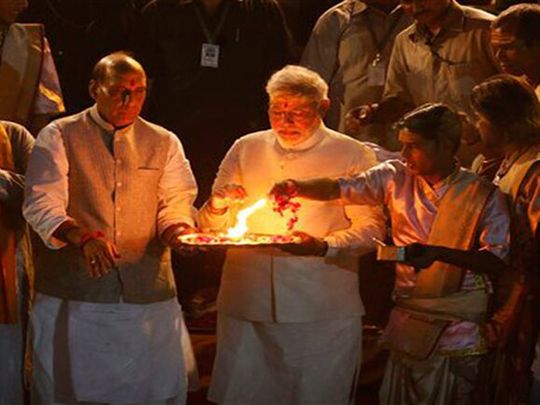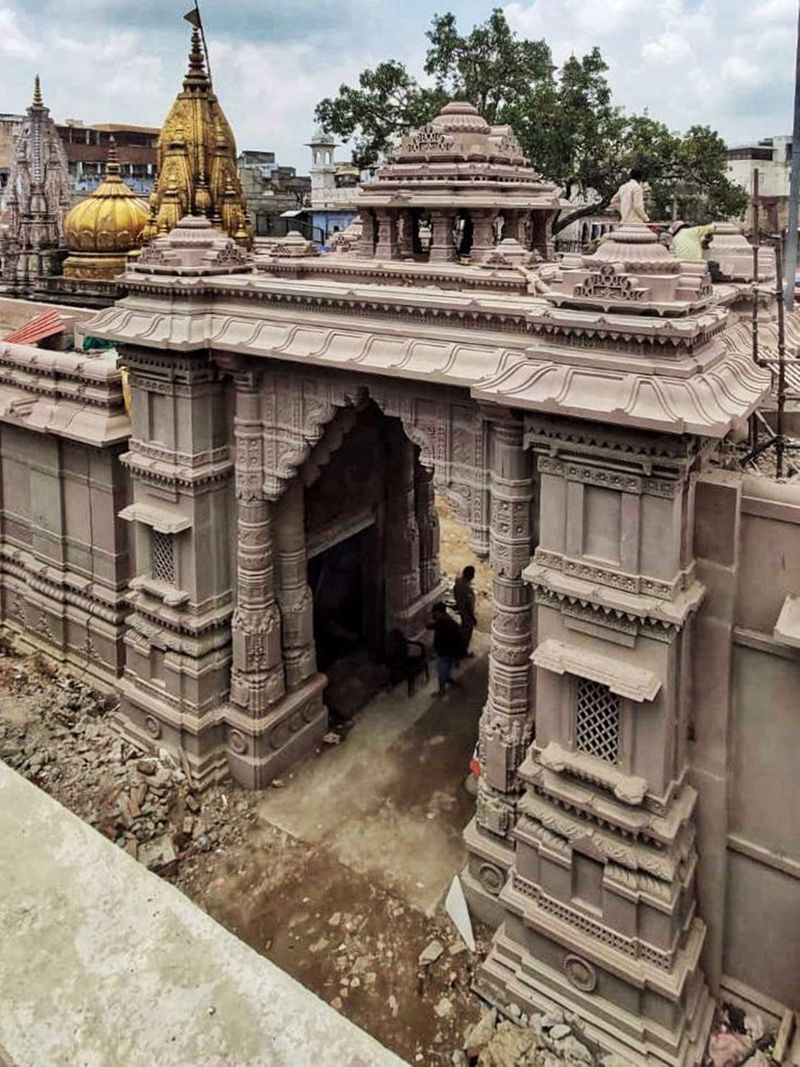
No Indian Prime Minister or member of parliament has changed any Indian city as fast as Narendra Modi is changing Varanasi, his parliamentary constituency.
Top-notch facilities are being created for Hindu pilgrims coming from all over India to worship lord Shiva in Kashi Vishwanath, one of the country’s most ancient temples.
Modi is expected to inaugurate the massive new project, designed by architect Bimal Patel, in or around December this year.
The project had its share of controversy when more than 400 properties including some homes were demolished and close to 70 temples were taken over by the project managers, paying around Rs 450 crores.
A city for all times
Varanasi, one of the oldest living cities on the planet, has been continuously inhabited for more than 2000 years. To Hindus, it is a holy place for liberation of one’s soul.
The trinity of Ganga (Ganges), Kashi Vishwanath temple of Shiva and Kashi city has created such magic that almost everyone finds the city interesting to understand the Indian society and mysticism of Hindu religion.
Modi has picked up his Varanasi theme accurately. He is connecting the two greatest symbols of Kashi: Baba’s temple and river Ganga.
The project will create a grand path of 350 metres connecting Ganga ghat to the Kashi Vishwanath temple via three grandly decorated gates.
Spread over 4.7 hectare area around the temple, it will have 29 new buildings, some built in the local Nagra school of design.

Restoring temple complexes
All over India millions are being spent to restore and develop temple complexes and build road connectivity by private sources and public funds under various heads of the ministries.
The UP government has created a Special Area Development Board for the projects.
Although a few intellectuals and prominent pundits have questioned Modi’s idea of development model for Varanasi but here in lies the rub: The “Kumbh Mela crowd” — those who stand in queues for hours — chanting Har Har Mahadev and Om Namo Shivay — to enter the Shiva temple along with others will applaud the easy, comfortable and clean access routes to temple.
The reimagining of Varanasi will further elevate Modi’s stature among his staunch supporters.
Deepak Agarwal, commissioner of Varanasi and the in-charge of the project told Gulf News that 20,000 pilgrims visit the temple each day. On Mondays of Shrawan (a holy month as per Hindu calendar) 200,000 people visit the temple.
Mahatma's connect to Varanasi
Modi’s administration is reminding those who oppose changes in the temple city of the famous speech by Mahatma Gandhi given after visiting the Vishwanath temple in 1916.
Then, Gandhiji had said, "Is it right that the lanes of our sacred temple should be as dirty as they are? The lanes are tortuous and narrow. If even our temples are not models of roominess and cleanliness, what can our self-government be?”
Bimal Patel has done the unthinkable in Varanasi. The legendary Manikarnika ghat, the holiest cremation ground in the Hindu culture, is finally entering the 21st century.
While the last rites of the dead will be same, modern well-designed pyres are being created. Manikarnika, Lalita and Jalasen ghats are being completely rebuilt.
Pilgrims can arrive via boats on newly built jetties from where they can proceed to the tourist facilitation centre. For old pilgrims, escalators and ramps are being built.
A place to chant, meditate and have peace
The complex has two restaurants, help-centre, Ganga viewing gallery, two museums, well-equipped hospice for the terminally ill patients, bookstore of spiritual books, a multi-purpose hall and a guesthouse to stay overnight.
However, the best part is the Mandir chowk around the old temple. It will give space to the pilgrims to chant, meditate and have peace. There is an open-air theatre on the riverbank, too.
Right now, many emotions run parallel in the city. There is a sense of loss among people who were spiritually attached to the old ambience, their own temples, had romanticism of worn-out homes of the last century and two-three feet wide narrow lanes and by-lanes.
Those who oppose Modi’s politics complain that this will change the rhythm of Varanasi. As the debate continues, so does the Prime Minister’s grand project.
More than 500,000 Muslims live in Varanasi. The Gyanvapi mosque stands cheek by jowl with the Vishwanath temple. But, the management of the mosque has set a historic example by giving a small plot of land to the new project.
Sayed Yasin, joint secretary of the Anjuma Intejamia Masajid, and caretaker of the Gyanvapi mosque told Gulf News, "The idea to develop temple is very good. We have no complaints as it poses no threat to the mosque. The complex will have a shopping mall too. It will help local economy.”
Says Badri Narayan, public intellectual and author of Republic of Hindutva, “By developing Ayodhya and Varanasi temple projects, on eve of the UP assembly election, Modi is sending a message to the people. It’s also a kind of cultural-tourism project. It will lift the local economy, generate employment."
"The aim is to enhance the pilgrim’s sense of identity. It will be the source of identity for the multiple sects of Hindus. Unlike Ayodhya, where lord Rama is revered, here Shaivites, followers of Kabir and Ravidas, and Vaishnavs all will identify with Bhavyata (grandeur) of the new Kashi Vishwanath complex," Narayan concludes.









